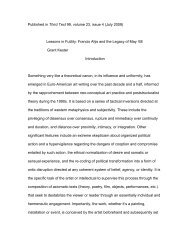Old Masters and New Lessons - Grant Kester
Old Masters and New Lessons - Grant Kester
Old Masters and New Lessons - Grant Kester
Create successful ePaper yourself
Turn your PDF publications into a flip-book with our unique Google optimized e-Paper software.
22. Ibid., 60/Ak216.<br />
23. Kant describes judgments of beauty as being "public"; ibid., 57/Ak214. David Wellbery links<br />
this "public" status to the concept of an "ideal speech situation" in the work of Jürgen Habermas<br />
<strong>and</strong> others: "The ideal of transparency, which in the Enlightenment was conceived in semantic<br />
terms, reappears in the work of Habermas <strong>and</strong> Apel as a pragmatic ideal: a communicational<br />
exchange in which subjects are transparent to themselves <strong>and</strong> others. . . . As was the case in<br />
Enlightenment theory, aesthetic representations point forward to a state of freedom in which the<br />
compulsions <strong>and</strong> opacities of speech are finally overcome"; Wellbery, Lessing's Laocoon, 242.<br />
24. Kant, Critique of Judgment, 164, 229, 228. Kant speaks of the sense of beauty as providing<br />
"a mental attunement [gunstige Gemutsstimmung] favorable to moral feeling" (165/Ak299). And<br />
he argues that someone who displays an interest in the beauty of nature must also have a<br />
"predisposition" (Anlage) to a good moral attitude (167/Ak301). Later he describes the way in<br />
which taste allows us to "make the transition" (macht gleichsam) between the realm of the<br />
senses ("sensible charm") <strong>and</strong> "habitual moral interest" "without making too violent a leap"<br />
(ohne einen zu gewaltsamen Sprung [229/Ak354]).<br />
25. Cascardi defines aesthetic liberalism in the following way: "The aesthetic moment in Kant<br />
replicates rather than resolves the tensions between the individual <strong>and</strong> the community that Kant<br />
elsewhere formulates as central to the position of the subject in the modern world. Whereas the<br />
Enlightenment reading of Kant [exemplified by Habermas] sees the third Critique as reflecting a<br />
development of the 'inner logic' of a self-contained aesthetic sphere, <strong>and</strong> tends to privilege the<br />
public discourse of taste over the experience of art itself, <strong>and</strong> whereas the Romantic response to<br />
Kant tends to see the Critique of Judgment as a reintegrative <strong>and</strong> redemptive attempt to restore<br />
unity through the formation of what Schiller called an 'aesthetic state,' to a social totality that had<br />
been shattered by the disintegrative forces of capital, I would suggest that . . . Kant leads us to<br />
conclude that the foundations of the liberal ethic reside not in the cognitive powers of mason or<br />
underst<strong>and</strong>ing, but in the (transcendental) imagination which regrounds the liberal state as the<br />
unity of wills under the concept of an end which has subjective claim to universality"; Anthony J.<br />
Cascardi, "Aesthetic Liberalism: Kant <strong>and</strong> the Ethics of Modernity," Revue Internationale de<br />
Philosophie 45, no. 176 (1991): 12-13.<br />
26. "Gorgeous Politics, Dangerous Pleasures," 15.<br />
27. I don't consider the nonprofit sector to be necessarily "purer" than the gallery world. Rather,<br />
the conditions of the market, economic exchange, <strong>and</strong> symbolic capital simply operate there in a<br />
different way. However, this difference is of considerable importance in terms of underst<strong>and</strong>ing<br />
the function of artists <strong>and</strong> institutions in each site. See <strong>Grant</strong> <strong>Kester</strong>, "Rhetorical Questions: The<br />
Alternative Arts Sector <strong>and</strong> the Imaginary Public," Afterimage 20, no. 6 (January 1993): 10-16.<br />
28. Aesthetic Education of Man, 43. Schiller writes: "Everlastingly chained to a single little<br />
fragment of the Whole, man himself develops into nothing but a fragment; everlastingly in his ear<br />
the monotonous sound of the wheel that he turns, he never develops the harmony of his being,<br />
<strong>and</strong> instead of putting the stamp of humanity upon his own nature, he becomes nothing more<br />
than the imprint of his occupation of his specialized knowledge"; ibid., 35.<br />
29. Hegel's Philosophy of Right, trans. T. M. Knox (London: Oxford University Press, 1952), 189.<br />
30. Schiller, Aesthetic Education of Man, 197.




